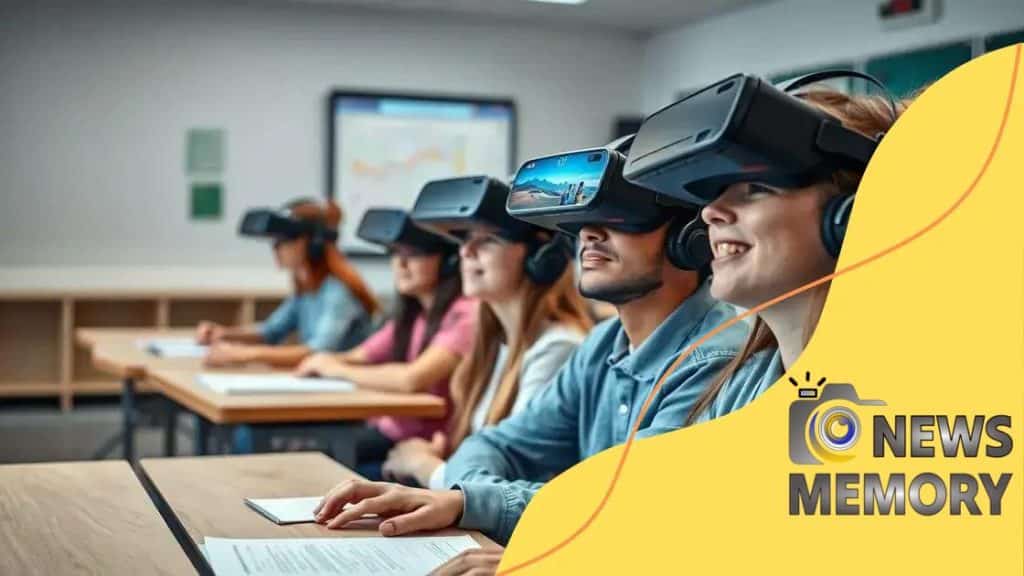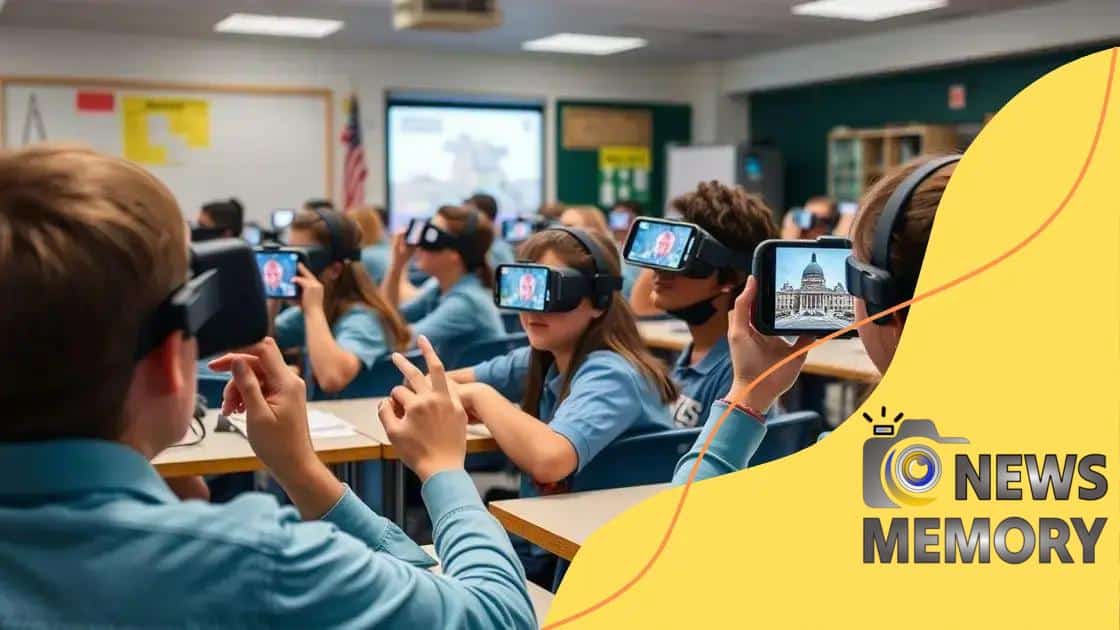How AR is being used for hands-on learning experiences

Augmented reality is transforming education by enhancing student engagement through interactive and immersive learning experiences, allowing for better visualization of complex concepts and fostering collaboration among peers.
How AR is being used for hands-on learning experiences is changing the way students engage with educational content. Imagine learning biology while virtually dissecting a frog or exploring the stars without leaving your classroom. Intrigued? Let’s dive into how augmented reality is shaping education.
Understanding augmented reality in education
Understanding augmented reality in education is key to unlocking new learning experiences. This technology blends digital information with the real world, providing students immersive insights into various subjects.
For instance, using AR, students can visualize complex scientific models right in their classrooms. With this technology, education becomes interactive, making learning not only exciting but also effective.
How AR Enhances Learning
By integrating augmented reality into educational environments, students gain a richer understanding of content. AR allows for:
- Interactive simulations that deepen comprehension.
- Immediate feedback on practical tasks.
- Visualizations of abstract concepts, such as geometry or biology.
This immersive experience encourages curiosity and engagement, which are essential for effective learning.
Moreover, augmented reality stimulates students’ creativity and critical thinking. As they interact with virtual elements, they can experiment and explore without limitations. The blend of real and virtual worlds opens doors to innovative problem-solving.
Practical Applications of AR in Classrooms
Teachers use augmented reality to bring history lessons to life. Imagine walking through ancient ruins or exploring the solar system from your desk! This engagement makes students more likely to remember what they learn.
In addition, educators find that AR allows for personalized learning. With tailored AR applications, every student can learn at their own pace, diving deeper into topics of interest. This adaptability is crucial in today’s diverse classrooms.
Ultimately, understanding augmented reality in education equips both students and teachers with tools that make learning enjoyable and effective. As technology advances, the possibilities are endless, pushing the boundaries of traditional education.
The benefits of AR for hands-on learning
The benefits of AR for hands-on learning are significant and varied. This technology enriches traditional learning methods, engaging students in ways that are both interactive and practical.
Students using AR can directly interact with digital elements superimposed on the real world. This helps them understand complex concepts deeply, as visual and tactile experiences enhance retention and interest.
Enhanced Engagement
First and foremost, augmented reality captures students’ attention. Learning becomes exciting when they can explore historical sites or conduct science experiments virtually. This level of engagement leads to:
- Improved focus during lessons.
- Increased participation in class activities.
- A genuine curiosity to explore subjects further.
As students interact with AR, they are more likely to stay engaged, which is crucial for effective learning.
Improved Learning Outcomes
Another key benefit of AR for hands-on learning is the improvement in learning outcomes. By providing immersive experiences, students grasp difficult topics more easily. For example, they can visualize the anatomy of the human body, seeing each organ in 3D. This clarity aids in comprehension and retention of knowledge.
Additionally, AR fosters critical thinking skills. Students learn to analyze information critically as they engage with interactive environments. They can experiment, ask questions, and observe results in real-time, which enhances their learning experience.
Overall, the integration of augmented reality into education transforms how students learn. The immersive, hands-on experiences provided by AR tools prepare them for real-world applications and careers, making education truly impactful.
Real-world examples of AR in classrooms

Real-world examples of AR in classrooms showcase how this technology can revolutionize education. Schools around the globe are adopting augmented reality to enhance learning experiences.
For instance, students can explore the human anatomy using AR apps. They see 3D models of organs and systems, allowing them to learn biology interactively. This visual approach helps solidify complex concepts.
Notable Applications of AR
Another exciting use of AR in classrooms is in history lessons. Students can use AR apps to visit ancient civilizations without leaving their desks. With a simple scan, they can view interactive timelines and 3D reconstructions of historic sites. This method brings history to life and sparks interest in the subject. Some notable applications include:
- Google Expeditions, which offers virtual field trips.
- Merge Cube, allowing hands-on learning with 3D models.
- Anatomy 4D, for interactive biology lessons.
- AR Flashcards, turning traditional learning into engaging experiences.
Teachers also use augmented reality to teach mathematical concepts. With AR apps, students can visualize geometric shapes and explore their properties in a 3D space. This hands-on experience makes learning math much more engaging and understandable.
Additionally, language learning benefits from AR as students interact with virtual characters to practice dialogue. This immersive experience enhances language skills and builds confidence in speaking. The combination of language and technology creates a dynamic learning environment.
Overall, real-world examples of AR in classrooms demonstrate how this technology can foster engagement and understanding among students. By providing hands-on and interactive learning experiences, AR empowers students to explore and learn in innovative ways.
Challenges of implementing AR technologies
Challenges of implementing AR technologies in the classroom can affect how educators use this exciting tool. While the benefits are clear, schools face some hurdles in adopting augmented reality.
One major obstacle is the cost of AR devices and software. Many schools work on tight budgets, and investing in the latest technology can be a significant challenge. Additionally, maintaining and updating the technology can strain resources.
Technical Issues
Another challenge is dealing with technical issues. Effective AR technologies require reliable internet and devices. In some schools, slow connections can hinder the use of AR apps. Technical problems can disrupt lessons, frustrating both teachers and students.
- Incompatibility with existing systems.
- Need for professional development for teachers.
- High-tech requirements may exceed school capabilities.
Moreover, not all educators feel comfortable using new technology. Some may need training to confidently integrate AR into their teaching. This lack of experience can limit the effective use of augmented reality in classrooms.
Additionally, privacy concerns arise when using AR applications. Schools must ensure that student data collected during AR activities stays secure. For parents, knowing how their children’s data is used can be a significant concern.
Adapting Curriculum
Finally, adapting the curriculum to include AR technologies can be a challenge. Teachers need to align digital activities with learning standards, which may require additional planning and creativity. Balancing traditional teaching methods with AR experiences may be tricky for some educators.
Despite these challenges, many educators remain hopeful. By addressing these issues, schools can harness the full potential of augmented reality to enhance learning experiences.
Future trends in augmented reality for education
Future trends in augmented reality for education promise to change the learning landscape dramatically. As technology evolves, educators and students can expect even more innovative uses of AR in classrooms.
One exciting trend is the integration of artificial intelligence with augmented reality. This combination can personalize learning experiences. AI can analyze students’ strengths and weaknesses, adjusting AR content to meet their specific needs.
More Interactive Learning Environments
We will also see more completely immersive learning environments. Imagine walking into a classroom where you can step into a virtual world. Students will not only see digital overlays but also interact with virtual beings and objects, enhancing engagement.
- Students can explore historical events as if they were there.
- Virtual laboratories for conducting science experiments safely.
- Personalized virtual tutors helping with challenging subjects.
This level of interaction will make education more effective and enjoyable. It lets students learn by doing—combining hands-on experience with theoretical knowledge.
Collaboration Across Distance
An additional trend is the expansion of collaboration through AR. With the rise of remote learning, students from different locations can participate in shared AR experiences. They can work together on projects in virtual spaces, regardless of where they are.
Students will also benefit from real-time feedback and coaching within their AR experiences. This immediate response can help them grow and improve more rapidly. Moreover, incorporating AR into field trips will allow students to explore distant locations without leaving the classroom.
Finally, we can anticipate a variety of educational resources becoming available. As AR technology becomes more accessible, a wide range of applications will emerge. These apps will cover different subjects and industries, making learning diverse and engaging.
In summary, the future trends in augmented reality for education show great promise. By embracing these advancements, we can create a more interactive, collaborative, and tailored learning experience for all students.
FAQ – Frequently Asked Questions about Augmented Reality in Education
What are the main benefits of using AR in education?
AR enhances engagement, makes learning interactive, and helps students visualize complex concepts, improving retention.
What challenges do schools face when implementing AR technologies?
Schools face challenges such as high costs, technical issues, and the need for teacher training to effectively use AR.
How can augmented reality personalize the learning experience?
AR can tailor content to individual students’ needs, allowing them to learn at their own pace and engage with materials that interest them.
What future trends can we expect from AR in education?
Future trends include more immersive AR experiences, enhanced collaboration among students, and the development of diverse educational resources.





